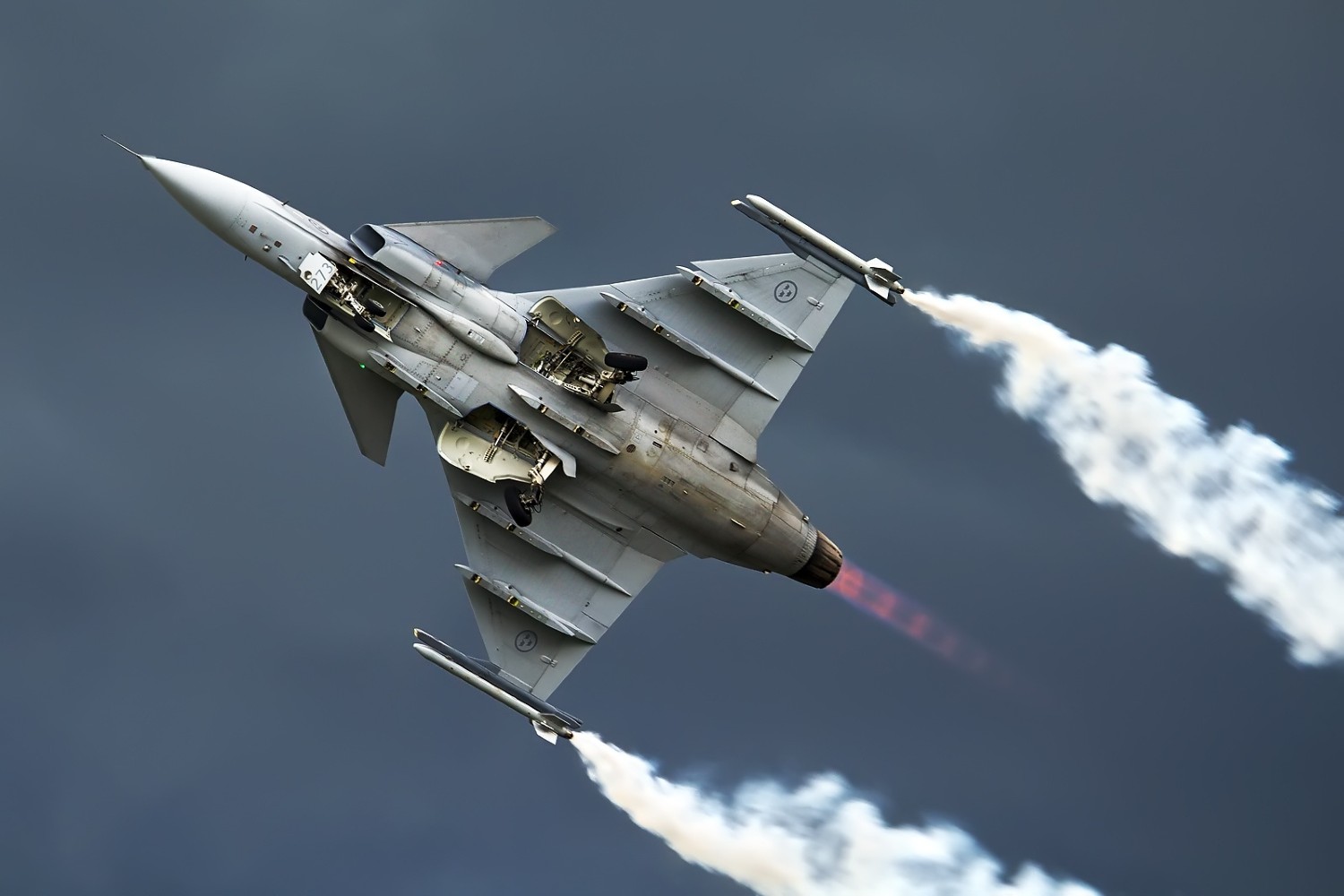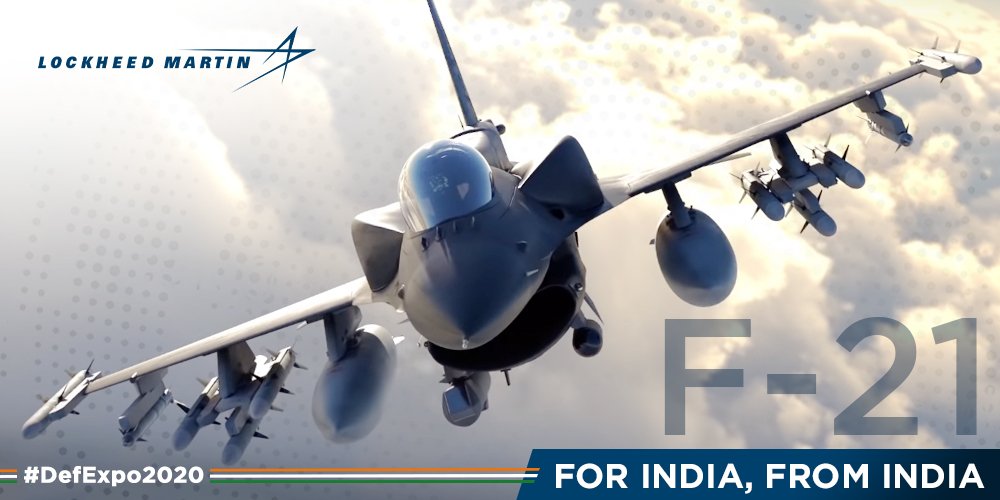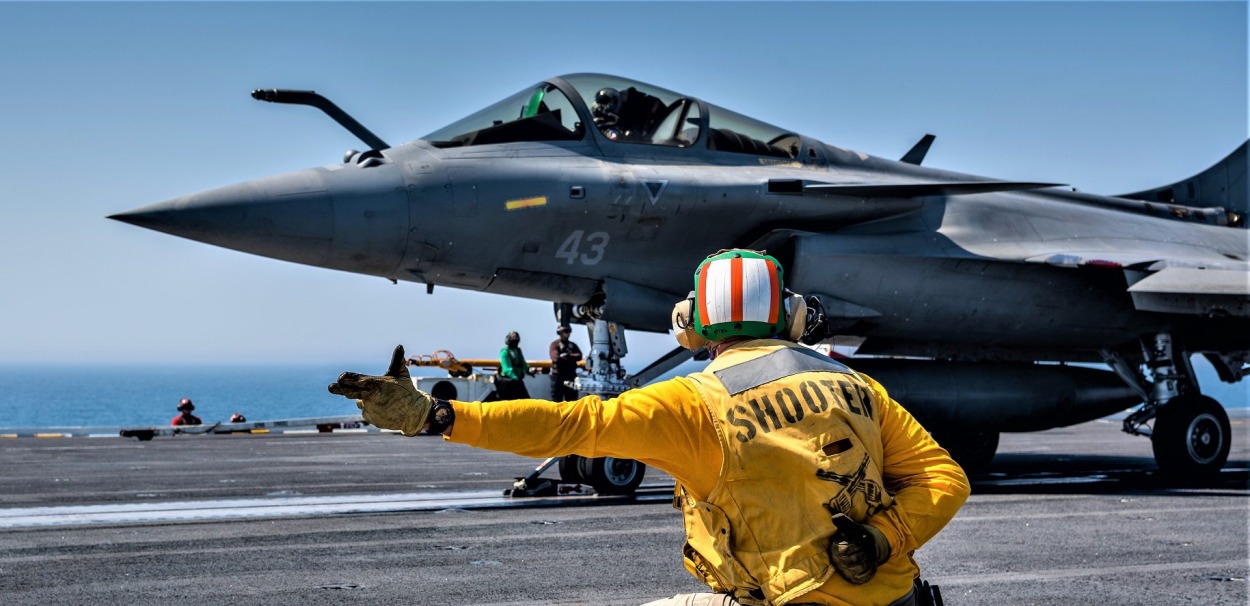Saab Gripen is one of the eight contenders for the IAF’s likely 114 Multi-Role Fighter Aircraft (MRFA). Swedish defense technology major Saab has now announced that it has partnered with local manufacturers to rapidly indigenize the platform.
If selected, it will also deliver the first Gripen E/F fighter aircraft, with significant indigenous content, within three years of the order.
It is also open to exploring manufacturing opportunities for the state-of-the-art fighter in India to serve local and global markets, along with a complete transfer of technology.
They can set up full-scale production in India, which will include everything: not just the airframe but also systems and software. They propose rapid indigenization supported by a host of private partners.
The MRFA Proposal
The Indian Air Force’s (IAF) 114 MRFA requirement was formally announced in April 2018 with a Request for Information (RFI). The Indian Navy also needed new fighter jets.
As many as eight fighters are in the fray for the RFI. These include the Boeing F/A-18E/F Super Hornet, Boeing F-15EX Eagle II, Lockheed Martin F-21 (a variant of F-16V with 14 India-specific customizations), Dassault Rafale, Eurofighter Typhoon, Saab JAS-39 Gripen E/F, Mikoyan MiG-35, and Sukhoi Su-35.
Later, as per the Indian government policy, it was decided that all the jets would follow the “Make in India” policy and be manufactured in India’s own production line.
The contract was expected to be valued at around $20 billion. Technology transfer in collaboration with local partners was to complement the deal. However, nearly six years after the response to the RFI was received, the contract tender or the Request for Proposal (RFP) has still to be sent out.
As per the latest reports in Indian media, the Modi government fully backs the Indian Air Force’s (IAF’s) plans to acquire 114 Multi-Role Fighter Aircraft (MRFA) and is aware of the fighter squadron’s depleting strength.
Saab JAS 39E/F Gripen
The Saab JAS 39 E/F Gripen is a light single-engine supersonic multirole fighter aircraft manufactured by the Swedish aerospace and defense company Saab AB.
The Gripen has a delta wing and canard configuration, a relaxed stability design, and fly-by-wire flight controls. The first flight took place in 1988, and the first serial production airplane was delivered in 1993.
The initial variant entered service with the Swedish Air Force in 1996. The latest variant, the JAS 39E/F Gripen, began entering service with the Swedish and Brazilian Air Forces in 2019.

JAS 39E is the single-seat production version developed from the Gripen NG program, and JAS 39F is the two-seat version. JAS 39 E/F has a larger fuselage, a more powerful engine, increased weapons payload capability, and a new cockpit, avionics architecture, electronic warfare system, and other improvements. As of 2023, more than 300 Gripen variants have been built.
There is a proposed carrier-based version of the Gripen E. There is also a proposed unmanned combat aerial vehicle (UCAV) variant of the Gripen E. Gripen EA is the proposed electronic warfare (EW) or Electronic Attack variant of the Gripen F.
The aircraft has been sourced roughly 67 percent from Swedish or European suppliers and 33 percent from the U.S. The engine, fuel, and hydraulics are sourced from outside Sweden, albeit from global OEMs.
On the other hand, the avionics, software, mission computers, system integration, data and sensor fusion, and practically all others are indigenous. These include radar and electronic warfare systems and weapon systems.
Sweden has offered to integrate Indian systems and weapons on the platform. Some operators have adopted the less expensive GE F414G power plant vis-à-vis the Eurojet EJ200. The version on offer to India can have a more powerful and expensive EJ-200 engine.
Saab Gripen had been a contender for the erstwhile MMRCA deal. But after nearly 15 years, the technologies offered on the Gripen E are the latest. Significant AI is embedded for quicker and better operational decision-making, and the network-enabled capabilities have been greatly enhanced.
One plus point is that all operators have access to Gripen’s source code and technical documentation, allowing for upgrades and new equipment to be independently integrated.
Saab has pledged to fully transfer Gripen E technology to India if it is awarded the contract. However, some in India have been concerned about the high level of US-supplied hardware, such as electronics, weaponry, and the GE-F414 engine.
The current operating countries are Brazil, the Czech Republic, Hungary, Thailand, and South Africa. Sweden is the only country with significant numbers, over 100. The UK’s Empire Test Pilots’ School operates one for training.
SAAB has tied with the Adani group as its production partner in India. The Swedish government supports the proposal. If India were to begin manufacturing the GE F414 in India, then that could be an advantage.
Boeing F/A-18IN
The Boeing F/A18E/F Super Hornet is a twin-engine multirole fighter. The aircraft evolved from the YF-17, which had lost the USAF competition, to the F-16 in the mid-1970s.
The F-18 first flew in 1978 as a Hornet and is operated by the US Marines and US Navy, Royal Australian, and Spanish Air Forces, among others. Nearly 1500 Hornets have been built.
The Hornet and Super Hornet have successfully participated in the Gulf and Middle East wars. The Super Hornet has a new, larger airframe and has seen extensive avionics upgrades. The aircraft is powered by 2 × General Electric F414-400 turbofans. The variant likely to be offered will be customized for India and called F/A-18IN, and it will have a newer AESA radar.
The Boeing and Tata joint venture, the Tata Boeing Aerospace Limited (TBAL) facility at Hyderabad, supports India as a global exporter of aerospace. The 14,000-square-meter facility makes the aerostructures of Boeing’s AH-64 Apache helicopter for customers worldwide.
This is the first time the Super Hornet is being offered for production in a foreign country. The Indian Navy also required a twin-engine deck-based fighter. They appear to have chosen to acquire 26 Rafale-M jets in preference to F-18s.
Boeing F-15EX Eagle II
The Boeing F-15EX Eagle II is an advanced two-seat variant of the F-15E Strike Eagle and made its maiden flight in February 2021. Improvements included the AMBER (Advanced Missile and Bomb Ejector Rack) system to carry up to 16 air-to-air missiles, AESA radar, infrared search and track, advanced avionics, and electronic warfare equipment, conformal tanks, and revised structure with a service life of 20,000 hours. The USAF went ahead with these to maintain fleet size as F-22 production ended. The USAF has ordered around 80 aircraft.
The Israeli Air Force ordered 25 F-15IA fighters and plans to upgrade 25 F-15Is to the F-15IA standard. The aircraft’s max take-off weight is 36.7 tons, similar in class to the Sukhoi Su-30 MKI’s 38.8 tons.
With over 260 Su-30 MKI with the IAF, India would have to take a call if it requires such a large aircraft in numbers more than the USAF.
Eurofighter Typhoon
The Eurofighter Typhoon is a twin-engine, canard-delta wing multirole fighter manufactured by a consortium of Airbus, BAE Systems, and Leonardo formed in 1986. Aircraft entered operational service in 2003, and around 600 have been built to date and flown by 10 Air Forces.
The fighter is powered by two Eurojet EJ200 engines. It is an agile fighter that has seen operations in Libya. Eurofighter, along with Rafale, was one of the two aircraft shortlisted after a technical evaluation during the MMRCA competition but lost out on the commercial bid.
Though a consortium, India would have to have a lead partner to enter into a contract. The aircraft upgrades include MBDA Meteor, Storm Shadow, and Brimstone integration. There are also upgrades to the AESA radar and Electronic suite.
Lockheed Martin F-21
The F-16 Fighting Falcon is a single-engine air-superiority, multi-role fighter aircraft that first flew in 1974 and has since been operated by 26 countries. It has been repeatedly upgraded, including changes to the airframe.
The aircraft today has the latest technologies, and modularity makes it easily further upgradable. The F-21 would be an India-specific Block 70 variant.
The aircraft will feature Northrop Grumman’s advanced APG-83 AESA radar and enhanced battle-space awareness avionics. Many weapons, including the latest versions of the AIM-120 AMRAAM, are also on offer.

The aircraft is powered by a GE F110-132A engine. Its structural life has been extended to allow it to fly until 2040. Operational capabilities are enhanced through an advanced data link, targeting pod, and weapons; precision GPS navigation; and the Automatic Ground Collision Avoidance System (Auto GCAS).
At one stage, the offer was to shift the entire F-16 manufacturing line to India and make India the global supply chain hub. With 2250 F-16 still flying in 26 countries, it would mean a very significant move.
Lockheed Martin has a joint venture company with Tata Advanced Systems Limited (TASL), which has proven expertise through the manufacture of airframe components for the C-130J airlifter and the S-92 helicopter. F-16 Wings are being produced in India for global customers. Lockheed Martin and Tata would produce the F-21 in India, for India.
Mikoyan MiG 35
The Mikoyan MiG-35 is a Russian multi-role fighter that is essentially a further development of the MiG-29M2. It was first presented internationally during Aero India 2007.
The single-seat version is designated MiG-35, and the two-seat version is designated MiG-35D. The fighter has improved avionics and weapon systems, including a new AESA radar and precision-guided targeting capability.
With the IAF having already upgraded the MiG-29s, India has already partially imbibed the technologies.
Sukhoi Su-35
The Sukhoi Su-35 is yet another upgrade of the Su-27 air-defense fighter family. It is a single-seat, twin-engine, super maneuverable, multi-role aircraft. The two-seater version resembles the Su-30MK family.
The Su-35 has a redesigned cockpit and weapons-control system, thrust-vectoring engines, and no canards. It made its first flight in February 2008. It is currently operated by the Russian Air Force and People’s Liberation Army Air Force (PLAAF).
With India having a very large number of Su-30MKI and a proposal to upgrade them, the Su-35 may not be that attractive.
Rafale
After a grueling selection process, the omni-role Rafale was the winner of the MMRCA tender. It has been operationally tested in Afghanistan, Libya, Mali, Iraq, and Syria.
The fleet is fully operational in the IAF. India has infrastructure for two airbases and has paid for one-time India-specific enhancements.
The F4 is the latest variant with radar and sensor upgrades that facilitate the detection of airborne stealth targets at long range and improved communications equipment for more effective network-centric warfare.
It is a variant on offer. In view of IAF’s depleting numbers, albeit expensive, one school of thought has been to order additional Rafale. The Indian Navy is likely to order the Rafale-M. These additional numbers would support Make-in-India.

Multiple Fleets Complexities
While the trend worldwide is to have limited fleet types, IAF continues to be mired by a multiplicity of fighter fleets with Jaguar, Mirage 2000, Su-30, MiG-21 & 29, LCA, and Rafale.
Adding more types would mean a continued logistics nightmare. Larger fleets can amortize costs and can maintain decent spare backups. Ideally, IAF should settle for SU-30 MKI, Rafale, and LCA fleets in the long run, with one new fighter and AMCA later.
Nearly 65 percent of the IAF remains of Russian origin. This dependency on a single country has to be reduced, and this became clearer after the Ukraine conflict.
My personal assessment is that in the next 20 years, India must target a percentage mix of 40 Indian, 30 Western, and 30 Russian.
To Summarise
The Indian Air Force (IAF) has a sanctioned strength of 42 fighter squadrons, but the service is currently down to 31 squadrons.
The IAF anticipated the phase-out of the MiG 21, 23, and 27 squadrons well in advance and made the case for 126 fighter aircraft as early as 2001.
The MMRCA purchase tender for 126 aircraft was floated in 2008 to fill the gap between the then-still-to-be-inducted LCA and the in-service Sukhoi Su-30MKI air superiority fighters.
The delays in indigenous LCA resulted in IAF squadrons continuing to reduce. Despite the IAF committing to 40 LCA Mk 1 and 83 plus 97 LCA Mk1A and having given tacit approval for as many as 120 LCA Mk II, the inductions remained slow.
The IAF is also fully backing the Indigenous Advanced Medium Combat Aircraft (AMCA). Meanwhile, the LCA Mk II will use a GE F414 engine, which will be manufactured in India. The same may also be used in the initial AMCA.
China has been pulling ahead in both numbers and quality. They have built nearly 300 fifth-generation J-20 aircraft. LCA Mk1A is currently behind schedule, but deliveries may still be completed by 2029.
The roll-out of the first prototype LCA Mk2 is expected by 2025, with the first flight within 2026 and mass production starting around 2029.
Operational deliveries may begin around 2029. India’s fifth-generation aircraft, the AMCA, may make its first flight around 2026-27. It can be inducted earliest, around 2035.
AMCA would require some foreign technological support, some of which can be factored into the new fighter selection package. Most major powers are reluctant to share the latest technologies, more so with one of the major arms importers.
The necessity of 114 additional fighters is very clearly spelled out. The starting point is the issuing of the RFP. Once the RFP responses are received, the chances are that many, if not most, will meet the technical specifications. To save time, the extent of evaluation would have to be decided. The commercial consideration and level of technology transfer on offer would decide the ultimate winner.
Any deal for the new fighter would have to have built-in the contract maximum technology transfer and support for India’s LCA, AMCA, AESA radar, and aircraft engine programs.
The Saab Gripen JAS-39 is the most recent aircraft with fairly modern technologies. Being an overall smaller political player for India, it will be easier to get a good deal from Saab.
They are willing to share the source code. However, only 300 Gripen are flying worldwide, giving little business leverage for exports. Also, the original Saab plant will not be shut down. Nearly 30 percent of aircraft systems are sourced from the USA, which can have complications later.
The F-18 is a twin-engine aircraft whose airframe has recently been redesigned. Boeing has a significant presence in the country. But if the Indian Navy goes ahead with Rafale-M, then the number of F-18s “Made in India” will reduce.
The F-16 is a single-engine aircraft with the largest fleet in the world, many of which will be flying well past 2040. India can get huge business worldwide for maintenance and overhauls.
With the MiG-29 upgrade, some of the technologies have already been imbibed, so the MiG-35 is unlikely to be a contender. Earlier, the Eurofighter lost out to Rafale on the commercial bid. New commercial bids would have to be seen. Rafale also has the advantage of a naval variant, thus the advantage of numbers.
Despite the much-refined DPP-2020, amended in 2022, the only contracts that seem to have gone through have all been G2G deals. All deals with the Soviet Union and Russians in the past were G2G.
Also, with Americans (P-8I, C-17, C-130, Apache, Chinook, and others) and French (Rafale), G2G deals save time, and price discovery is built. A G2G approach would be the best for the selected fighter for both cost and time savings. An early decision is operationally most critical.
- Air Marshal Anil Chopra (Retired) is an Indian Air Force veteran fighter test pilot and former Director-General of the Center for Air Power Studies in New Delhi. He has been decorated with gallantry and distinguished service medals while serving in the IAF for 40 years.
- He tweets @Chopsyturvey
- Follow EurAsian Times on Google News




